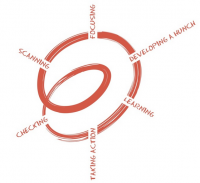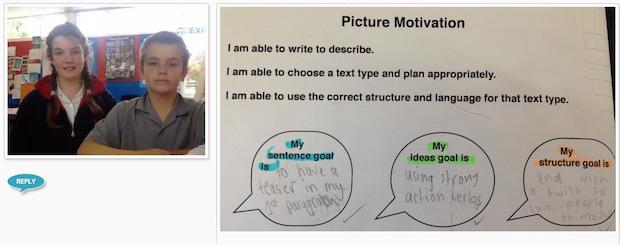Using Spirals of Inquiry to transform practice and raise literacy levels for boys
Tags: English | Teacher inquiry | Collaborative tools | Communication | Multimedia – video | Presentation | Primary |
Fendalton Open Air School teachers collected and analysed a range of data to enhance their writing programme and engage learners.
Focusing the inquiry
Teachers, Sue Gordon and Judy Harford from Fendalton Open Air School used Halbert and Kaser’s Spirals of Inquiry (2013) to transform their teacher practices and raise literacy levels for boys in their classrooms.
A fundamental part of this process was:
- improving data collection
- developing student agency
- determining what quality feedback looks like
- collaborating with parents, teachers, and peers as critical friends.
Judy and Sue collected relevant information from the boys and their families, alongside asTTle data and anecdotal evidence, as a part of the scanning and focusing phase of the Spirals of Inquiry framework. This included:
- using learner maps to identify the boys’ strengths, interests, experiences, and knowledge
- having learner consultations to assess the boys’ attitudes and behaviours towards their writing and learning
- using both of the strategies above to explore the impact of whānau engagement in the writing process.
This information was examined to determine the role teachers, parents, and peers could play to support the development of the boys’ writing potential. Judy and Sue realised the following important points.
Discussion is an important part of the writing process
During the learning consultations, the boys revealed that if given the opportunity to talk about their writing, they could articulate ideas, identify difficulties, and explore their learning needs. For Judy and Sue, this emphasised the importance of processing time and giving feedback in writing. So they established "talk-time" for all students in their writing programme.
Collecting different types of data is crucial
Learner maps and consultations revealed “hidden data” not collected from asTTle or writing samples. This showed the need for boys to talk about ideas and receive feedback throughout the writing process.
“Gathering writing samples is not enough evidence. Give learners a voice. Ask them about their learning, but be sure to wait and listen to the answer. If you really want to support your learners listen without prompting or filling in the gaps.”
Teacher reflection
Including whānau in the writing process is important
The learner consultations highlighted the need to inform and include whānau to support the boys with developing their ideas, structure, and language when writing. The boys had been focusing on the areas where whānau had given feedback, such as spelling or neatness, rather than on the content.
Using digital technologies
Judy and Sue utilised Google Apps for Education due to its inbuilt features such as the comments, dictionary, thesaurus, and research capability. They hoped the platform would raise levels of engagement, allow a wider audience for the boys’ writing, and improve the quality of content.
The boys' engagement and motivation immediately improved using the Google platform. However, there was no development in the quality of their writing content. Judy and Sue realised they would need to revisit their inquiry, and their approach, to improve learning outcomes.
By reviewing the comments within the boys’ Google documents, Judy and Sue identified the boys weren’t making the connection between their goals and steps for improvement. Judy and Sue concluded the boys needed more explicit instruction to understand their writing goals.
Together, the boys and teachers explored the Kid-speak writing progressions , which support learners in self-regulating their learning. The boys used the writing progressions to set individualised goals, taking responsibility for their own progress through self-monitoring and self-direction. This strategy gave the boys a deeper understanding of how to improve the quality of their writing. Judy and Sue explored processes for giving and receiving explicit synchronous and asynchronous goal-based feedback. They regularly addressed the boys writing goals and modelled effective feedback on the writing based on each student's goals.
Developing partnerships and relationships to support boys learning
As part of student-led conferences the boys were asked to model guidelines for providing quality feedback to their parents. They introduced the Movenote app , which allows students to record a video alongside documents or pictures. The boys used this tool to teach others, including their whānau, about goal setting and giving quality feedback.
Outcomes
Target learners’ achievement improved in all key skills assessed in the e-asTTle rubric , progressing from less than 2B to ranging from 2A–4B. Improvement was also evidenced by the boys:
- greater levels of focus and concentration
- developing more comprehensive personal writing goals
- self-regulating writing behaviours
- expressing a greater ownership of their learning
- taking risks with vocabulary and ideas
- using spellcheck confidently to identify correct spelling options
- seeking explicit feedback
- being enthusiastic about writing with increased motivation to continue at home
- gaining confidence as leaders and teachers, using Google Docs and Movenote to instruct whānau on the writing process.
Whānau have expressed pride in the progress their children have made and the improved confidence and ability in their boys’ writing.
Summary
The teachers consistently re-visited the Spirals of Inquiry framework to check, evaluate, and monitor the effectiveness of their approach.
“Teaching inquiry questions change and grow and go off on tangents or circle back on themselves depending on the data and what you do with it. It’s about us as teachers...it’s all about improving your practise.”
Teacher reflection
Sue and Judy realised the value of getting support for their inquiry. They sought and found further evidence, knowledge, and expertise from a range of sources, including:
- A framework for transforming learning in schools: Innovation and the spiral of inquiry
- Effective Literacy Practice in Years 1 to 4 and Effective Literacy Practice in Years 5 to 8 Ministry of Education handbook for effective feedback.
- Tapping into existing knowledge throughout the school and in the community.
By engaging in a genuine inquiry process, Sue and Judy were able to analyse and deconstruct their teaching practice in a meaningful way. They gathered student voice and incorporated whānau involvement. They were innovative in their approach to addressing their learners’ needs and used digital technologies to support this. It was not the digital technology alone that improved the boys’ writing, but the way it was used to develop partnerships to support their learning. Utilising the Spirals of Inquiry framework, valuing student voice, and agency, supported by the use of e-learning tools, was key to creating authentic and positive change in this approach.

